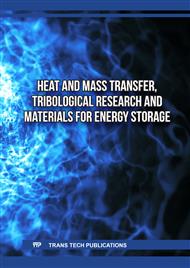[1]
Mehmood, S.; Iqbal, M.T; Jahangeer, Thermal analysis of a longitudinal fin with variable thermal conductivity and heat transfer coefficient using collocation method. Case Studies in Thermal Engineering (2020) 20-22.
Google Scholar
[2]
Sobamowo M.G, and Bayo Y. Ogunmola, FVM: Convective Longitudinal Temperature Dependent Thermal Conductivity and Internal Heat Generation, Defect and Diffusion Forum. 374 (2017) 106-120.
DOI: 10.4028/www.scientific.net/ddf.374.106
Google Scholar
[3]
Alshaghi, A.; Zayoud, A.; Chamkha, A.J, Thermal analysis of a longitudinal fin with temperature-dependent thermal conductivity and heat transfer coefficient using the spectral quasi-linearization method, International Journal of Thermal Sciences (2023) 184.
Google Scholar
[4]
Khani, F. and Aziz, A., Thermal Analysis of Longitudinal Trapezoidal Fin with Temperature Dependent Thermal Conductivity and Heat Transfer Coefficient, Common Nonlinear Sci., (2010).
DOI: 10.1016/j.cnsns.2009.04.028
Google Scholar
[5]
Sobamowo M.G, Thermal Analysis of a Convective - Radiative Moving Porous Trapezoidal Fin with Variable Thermal Properties and Internal Heat Generation using Finite Element Method, World Scientific News (2021).
Google Scholar
[6]
Hong-Seu Kou and Ji-Jen Lee, Thermal Analysis of a Longitudinal Fin with Variable Thermal Properties: Recursive Formulation, Heat and Mass Transfer (2005).
DOI: 10.1016/j.ijheatmasstransfer.2004.12.038
Google Scholar
[7]
Aziz A. and Mohsen T., Convective-Radiative Fins with Simultaneous Variations of Thermal Conductivity, Heat Transfer Coefficient, and Surface Emissivity with Temperature, Wiley Periodicals, Inc. Heat Trans Asian Res. (2012) pp.99-113.
DOI: 10.1002/htj.20408
Google Scholar
[8]
Vaishnav, Comparative Analysis on Heat Transfer of various Fin Profile suing Solid Works: A Symmetric View, in IOP Conference Series: Earth and Environmental Science (2021).
Google Scholar
[9]
Ambeprasad S. Kushwaha, and Prof. Ravinda Kirar, "Comparative Study of Rectangular, Trapezoidal and Parabolic Shaped Finned Heat Sink," IOSR Journal of Mechanical and Civil Engineering, 5 (2013) pp.1-7.
DOI: 10.9790/1684-0560107
Google Scholar
[10]
Jayaprakash M.C,, Thermal Distribution through a Moving Longitudinal Trapezoidal Fin with variable Temperature-Dependent Thermal Properties using DTM-Pad Approximant, Case Studies in Thermal Engineering, (2021).
DOI: 10.1016/j.csite.2021.101697
Google Scholar
[11]
F. Khani, M. Ahmadzadeh Raji, H. Hamedi Nejad, Analytical Solutions and Efficiency of the Nonlinear Fin Problem with Temperature-Dependent Thermal Conductivity and Heat Transfer Coefficient, Elsevier, (2009).
DOI: 10.1016/j.cnsns.2009.01.012
Google Scholar
[12]
Arman I. and Murteza S., Thermal Performance Evaluation of Longitudinal Fins with Various Profiles Using HPM, Iran Journal for Science Technology (2020).
Google Scholar
[13]
Dangui-Mbani, Ulric Olivier et al, Heat Transfer Analysis for a Free Boundary Problem arising in n-Diffusion Equation, Propulsion and Power Research, (2015).
DOI: 10.1016/j.jppr.2016.11.001
Google Scholar
[14]
Elyas Shivanian, Thermal Analysis of Longitudinal Fin with Temperature-Dependent Properties and Internal Heat generation using Optimized Chebyshev Polynomials., DE Gruyter, (2019).
DOI: 10.1515/ijnsns-2018-0017
Google Scholar
[15]
Navid Namdari, Numerical Solution for Transient Heat Transfer in Longitudinal Fins, International Research Journal of Advanced Engineering and Science, 3 (2018) pp.131-136.
Google Scholar
[16]
Ranganayakulu Ch., The Effects of Longitudinal Heat Conduction in Compact Plate-Fin and Tube-Fin Heat Exchangers using Finite Element Method, Elsevier Science Limited, International Journal of Heal and Mass Transfer, (1997).
DOI: 10.1016/s0017-9310(96)00182-2
Google Scholar
[17]
Naga G., Thella A.K, Ajay R.K, Experimental Investigatiion of Heat Transfer through Rectangula and Trapezoidal Fins: Aluminium 6063 Alloy, International Research Journal of Engineering and Technology ,07, no. 03, (2020).
Google Scholar
[18]
Bouchenafa R., "Numerical Study of the Thermal and Hydraulic Performances of Heat Sink made of Wavy Fins," Mechanics and Mechanical Engineering, (2019) pp.150-161.
DOI: 10.2478/mme-2019-0021
Google Scholar


